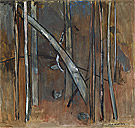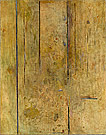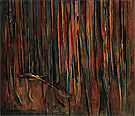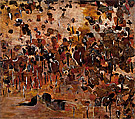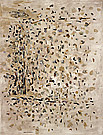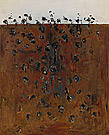Classic Williams
The decade of the 1960s was a period of breakthrough and consolidation of Fred Williams’s distinctive vision. Above all he was recognised for his fresh approach to depicting the local environment. His ability to evoke the essence of his subjects was apparent early in the decade in paintings of gum trees and sapling forests, distilled into vertical, linear compositions and imbued with luminous colour.
His major innovations came with the You Yangs and the Upwey series. The You Yangs paintings were infused with small sensuous touches suggesting the scrubby bush with no horizon. The Upwey landscapes, by contrast, introduced a definite horizon line; a precise division between heavily worked grounds and skies dotted with lively plant-like notations.
Williams was able to see qualities in the environment that others might miss – the random scatter of trees, bushes and rocks across open ground. As he said: ‘In Australia there is no focal point. Obviously it was too good a thing for me to pass up.’ Rather than adopting conventional perspective, space is flattened and tilted towards the viewer, implying the microcosm within the macrocosm and an aerial viewpoint.
By 1965 his clear-sighted, inventive response to place struck such a chord that aspects of the landscape were readily described as ‘classic Fred Williams country’.




